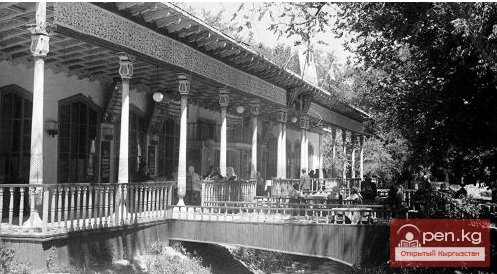MARKET REVIEW OF THE FRUNZE CITY HEALTH DEPARTMENT ON WORK FOR 1932
Frunze, February 20, 1933
The last year of the first five-year plan is characterized by significant growth in the healthcare system of Frunze, an increase in the number of medical personnel, and the development of sanitary and preventive institutions. In the pre-revolutionary period, there were 3 doctors in Frunze, and as of January 1, 1933, there were 70 doctors of various specialties. Before the revolution, there was 1 women's outpatient clinic and 1 hospital, which was military-owned. The comparative figures for the last 3 years of the first five-year plan for the network of medical and preventive institutions in the city are as follows:
Outpatient care in 1932 was concentrated in 4 outpatient clinics with a total of 21 offices and an annual throughput of 100630/13875.
Large enterprises in the city with up to 500 workers were provided with medical assistance on-site. As of January 1, 1933, 14 health points were organized at enterprises, including 8 medical and 6 paramedic points: 1) mechanical plant, 2) cationic factory, 3) road construction of Chustroy, 4) brick factory, 5) leather factory named after Zelensky, 6) suburban economy of CPS, 7) Raskidaivka, 8) Kommunstroy, 9) Kirsroy, 10) printing house, 11) Kirpromshveydodezhda, 12) Intergelpo, 13) meat processing plant, 14) Asia-bread.
The throughput of the latter for the year was 67504/7649.
In addition, health points not only provided medical services but also conducted preventive vaccinations against smallpox and typhoid fever.
Health points also participated in anti-epidemic measures, such as sanitation processing and inspection of dormitories.
In terms of sanitary education, discussions and lectures on various topics were held at enterprises by both the health points and doctors, totaling up to 101 discussions and 15 lectures.
In the area of maternal and child health, the City Health Department for 1932 had: a maternity hospital with 50 beds, an annual throughput of 2843. A children's hospital with 60 beds, with children admitted over the year... A children's consultation center with an annual throughput of 6745/2286. A milk kitchen served throughout the year (numbers not specified).
A children's outpatient clinic with 4 offices: ear, eye, internal, and dental, with an annual throughput of 13219/1738 for 1932.
Special assistance for insured residents of the city:
1. Tuberculosis dispensary - annual throughput (numbers not specified)
2. Venereal disease dispensary - 3032/10318
3. Tuberculosis sanatorium with 25 beds - annual throughput (numbers not specified)
4. Sanitary bacteriological laboratory with 4 departments and a Pasteur station serving all of Kyrgyzstan.
5. Malaria station with 2 offices, annual throughput (numbers not specified).
Resort Medical Assistance
Resort medical assistance was expressed in sending patients to local and central resorts: in 1931 - 132 people, in 1932 - 152 people to local resorts, and to central resorts 17 people in 1931, 22 people in 1932. A total of 1205 people were processed through the resort commission in 1931, and 8322 people in 1932. Additionally, 43 people in 1932 received reimbursement for travel expenses to various resorts back and forth at the expense of the City Health Department.
Patients were sent for inpatient treatment in various cities:
A total of 96 people were sent in 1931, and 173 people in 1932. The light therapy clinic of the NKZdrav of the Kirghiz ASSR transferred for special treatment of insured residents of the city - 48 thousand rubles.
Medical Personnel
As of January 1, 1933, there were 70 doctors remaining, with 19 doctors arriving in 1932 and 10 doctors leaving. 21 doctors received a 10% bonus for working in remote areas, and 5 doctors received a 25% bonus. In 1932, 70 people were sent for advanced training courses in various cities, and 65 doctors were granted labor leave. The average and lower medical staff were, with few exceptions, recruited from our medical college and ROKK courses. A total of about 400 medical workers were employed in the city's healthcare institutions. With these resources, the city health department actively participated in various political and anti-epidemic campaigns, such as sowing, harvesting, conscription, and servicing fairs and collective farm markets by creating separate brigades and sending them to the regions through the NKZ during the sowing and harvesting seasons, with 21 brigades created. Anti-epidemic teams were sent to the regions - 11 in total. For the servicing of conscripts born in 1910, 9 doctors were allocated.
Conscripts were accepted out of turn at all medical and preventive institutions. During the Soviet fair, 3 exhibitions were organized, and lectures were given both on the radio and at places of public gathering: tea houses, canteens...;
Head of the City Health Department Chistyakova
CGA KR. F. 678. Op. 5. D. 23. L. 117-118. Original.
Passport of the city of Frunze from 1930 to 1933. Document No. 85

















































